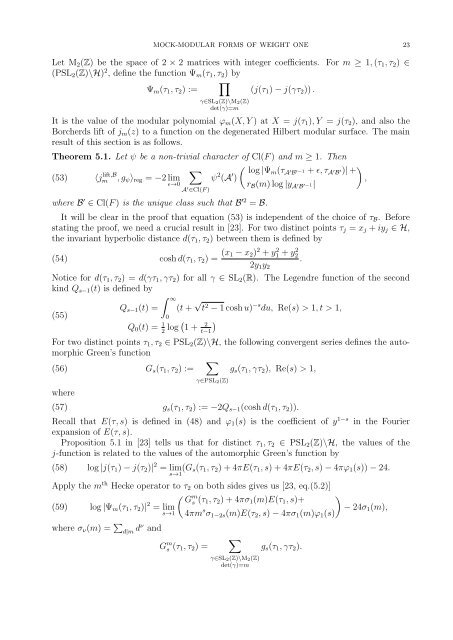Mock-modular forms of weight one - UCLA Department of Mathematics
Mock-modular forms of weight one - UCLA Department of Mathematics
Mock-modular forms of weight one - UCLA Department of Mathematics
Create successful ePaper yourself
Turn your PDF publications into a flip-book with our unique Google optimized e-Paper software.
MOCK-MODULAR FORMS OF WEIGHT ONE 23<br />
Let M 2 (Z) be the space <strong>of</strong> 2 × 2 matrices with integer coefficients. For m ≥ 1, (τ 1 , τ 2 ) ∈<br />
(PSL 2 (Z)\H) 2 , define the function Ψ m (τ 1 , τ 2 ) by<br />
∏<br />
Ψ m (τ 1 , τ 2 ) :=<br />
(j(τ 1 ) − j(γτ 2 )) .<br />
γ∈SL 2 (Z)\M 2 (Z)<br />
det(γ)=m<br />
It is the value <strong>of</strong> the <strong>modular</strong> polynomial ϕ m (X, Y ) at X = j(τ 1 ), Y = j(τ 2 ), and also the<br />
Borcherds lift <strong>of</strong> j m (z) to a function on the degenerated Hilbert <strong>modular</strong> surface. The main<br />
result <strong>of</strong> this section is as follows.<br />
Theorem 5.1. Let ψ be a non-trivial character <strong>of</strong> Cl(F ) and m ≥ 1. Then<br />
∑<br />
( log |Ψm (τ<br />
(53) 〈jm<br />
lift,B , g ψ 〉 reg = −2 lim ψ 2 (A ′ A<br />
)<br />
′ B ′−1 + ɛ, τ A ′ B ′)| + )<br />
ɛ→0<br />
r B (m) log |y A ′ B ′−1| ,<br />
A ′ ∈Cl(F )<br />
where B ′ ∈ Cl(F ) is the unique class such that B ′2 = B.<br />
It will be clear in the pro<strong>of</strong> that equation (53) is independent <strong>of</strong> the choice <strong>of</strong> τ B . Before<br />
stating the pro<strong>of</strong>, we need a crucial result in [23]. For two distinct points τ j = x j + iy j ∈ H,<br />
the invariant hyperbolic distance d(τ 1 , τ 2 ) between them is defined by<br />
(54) cosh d(τ 1 , τ 2 ) = (x 1 − x 2 ) 2 + y1 2 + y2<br />
2 .<br />
2y 1 y 2<br />
Notice for d(τ 1 , τ 2 ) = d(γτ 1 , γτ 2 ) for all γ ∈ SL 2 (R). The Legendre function <strong>of</strong> the second<br />
kind Q s−1 (t) is defined by<br />
∫ ∞<br />
Q s−1 (t) = (t + √ t 2 − 1 cosh u) −s du, Re(s) > 1, t > 1,<br />
(55)<br />
0<br />
Q 0 (t) = 1 log ( )<br />
1 + 2<br />
2 t−1<br />
For two distinct points τ 1 , τ 2 ∈ PSL 2 (Z)\H, the following convergent series defines the automorphic<br />
Green’s function<br />
(56) G s (τ 1 , τ 2 ) := ∑<br />
g s (τ 1 , γτ 2 ), Re(s) > 1,<br />
where<br />
γ∈PSL 2 (Z)<br />
(57) g s (τ 1 , τ 2 ) := −2Q s−1 (cosh d(τ 1 , τ 2 )).<br />
Recall that E(τ, s) is defined in (48) and ϕ 1 (s) is the coefficient <strong>of</strong> y 1−s in the Fourier<br />
expansion <strong>of</strong> E(τ, s).<br />
Proposition 5.1 in [23] tells us that for distinct τ 1 , τ 2 ∈ PSL 2 (Z)\H, the values <strong>of</strong> the<br />
j-function is related to the values <strong>of</strong> the automorphic Green’s function by<br />
(58) log |j(τ 1 ) − j(τ 2 )| 2 = lim<br />
s→1<br />
(G s (τ 1 , τ 2 ) + 4πE(τ 1 , s) + 4πE(τ 2 , s) − 4πϕ 1 (s)) − 24.<br />
Apply the m th Hecke operator to τ 2 on both sides gives us [23, eq.(5.2)]<br />
( G<br />
m )<br />
(59) log |Ψ m (τ 1 , τ 2 )| 2 s (τ 1 , τ 2 ) + 4πσ 1 (m)E(τ 1 , s)+<br />
= lim<br />
s→1 4πm s σ 1−2s (m)E(τ 2 , s) − 4πσ 1 (m)ϕ 1 (s)<br />
where σ ν (m) = ∑ d|m dν and<br />
G m s (τ 1 , τ 2 ) =<br />
∑<br />
γ∈SL 2 (Z)\M 2 (Z)<br />
det(γ)=m<br />
g s (τ 1 , γτ 2 ).<br />
− 24σ 1 (m),
















